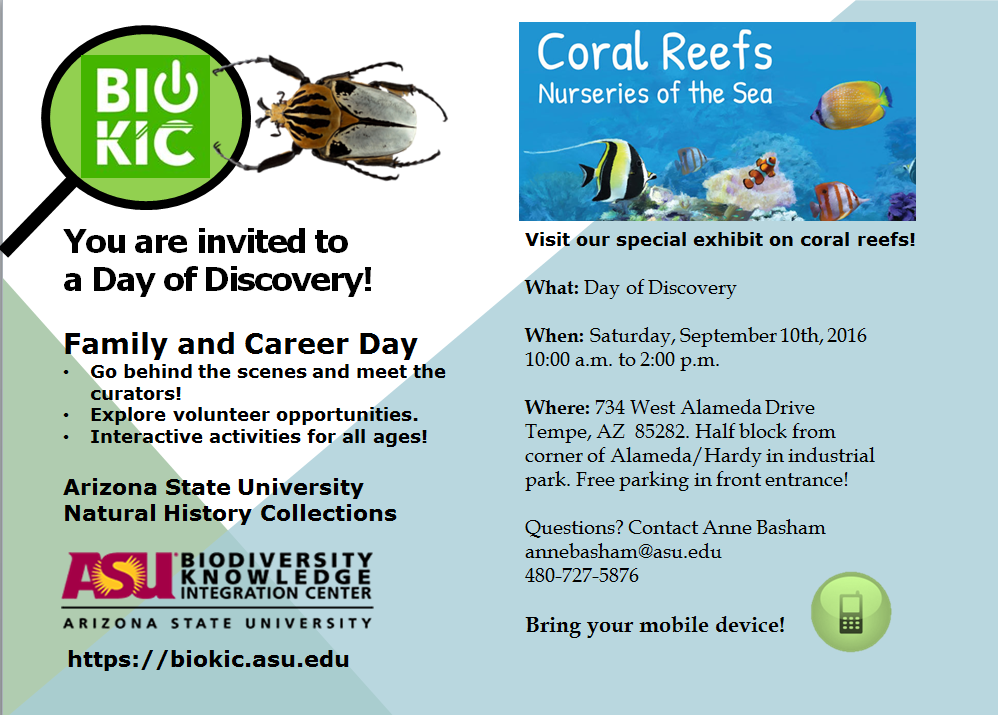The Arizona State University, Biodiversity Knowledge Integration Center (BioKIC), is offering a new internship for an undergraduate computer science student to develop and maintain the Symbiota software platform code base. Symbiota (https://symbiota.org/) is an open-source software for managing and mobilizing biodiversity data. Over the span of 20 years, Symbiota has developed into a distributed network of theme-based research portals incorporating data from over 1,900 biodiversity collections of preserved plants, animals, fossils, fungi, and more. The... Read More
By Alexander Fenlon
During the first week of our program, we visited a lab associated with the Central Arizona–Phoenix Long-Term Ecological Research as part of our campus tour. Gawking at a worktable covered in dusty plant samples, taking puzzled glances at pouches filled with nothing but atmospheric gases, and snaking past each other as we crammed into a room-sized freezer, we were privy to myriad facets of our local ecosystem in perfect isolation: crystal-clear data.
We were waving our goodbyes when a pleading cry was issued from the end of the corridor.... Read More
This is a guest post by 2022 Biocollections Summer Scholars Program alum, Tommy Thiatmaja.
It was a starry night and my phone showed that it was 100+ degrees. I approached a white sheet with a UV light, equipped with a strange tubular device and a vial of what smelled like alcohol and acetone. The insects were buzzing loudly around me with some of them flying into my ears, eyes, and even my pants. I put the tubular device to my mouth and began to capture insects by literally sucking them into a tube with my mouth. After spending an hour catching bugs, I... Read More
This is a guest post by 2021 Biocollections Summer Scholars Program alum, Faith Cisneros.
Consumed by the way each thick hair lay defined, colored like a piece of old dry wood that has begun to fade, I imagined the stiff body revitalizing within moments of focusing on it. I drew in a quick breath of air before I began to untangle what the life of the moth under my microscope must have been like. The white lit background of the microscope quickly faded into... Read More
Dear Research Community:
In August 2018, Arizona State University's (ASU) Biocollections and Biodiversity Knowledge Integration Center were selected by the National Ecological Observatory Network (NEON) leadership to be the NEON Biorepository, potentially for the full 30-year duration of the project as presently designed.
Latest NEON release on the Biorepository... Read More
This morning, I had a new paper published on the beautiful darkling beetles in the genus Eleodes - commonly known as the 'Desert Stink Beetles'. In this paper I described a new species I discovered from doing field work in Nevada during the summer of 2015. When I tell people about my research, that I discover and describe new species of beetles, I am more often than not greeted with surprise and the question "I thought we knew all the species on the planet, how do you find new ones?" This blog post is my attempt to explain the process by telling the story of Eleodes... Read More

Are Herbaria Still Relevant in the 21st Century?
By Walter Fertig, Arizona State University herbarium
Originally published in Sego Lily 2016 Vol 39(1):6-8.
The oldest herbaria date to the Middle Ages when European physicians first learned that dried and pressed plants could retain their color and appearance for decades if properly preserved. Initially specimens were bound in books to provide doctors with a handy reference for identifying the sources of herbal medicines. Over time it became more convenient to keep specimens on loose sheets that could... Read More
